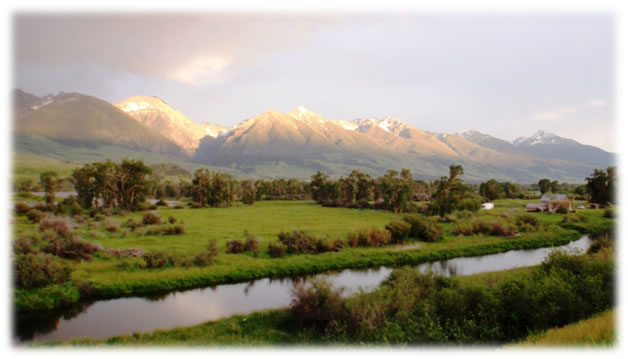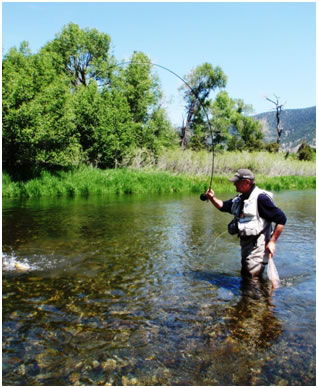EVENINGS ALONG THE STREAM (part 1)
This is a story of adaptability, observation and a willingness to keep an open mind. There is no doubt that fly anglers are creatures of habit. I have client whom I have fished for years and each year when they roll over their bookings it is so they can return to a certain area at a specific period of time where they have become familiar with the hatches and conditions that they hope to encounter. Even though I have preached preparation and the pursuit of knowledge for years most of those who use guides, and many of those who don't, show up hoping to encounter a situation that they are comfortable with. Those who employ guides fully expect, and justifiably so, that the guides are on top of the situation and know how to instruct the clients so that the unusual situation can be overcome and the angler will experience another thrilling fly fishing adventure on the water.

2011 was such a year, however many anglers were unprepared for what was about to transpire. I have now been guiding fly anglers for thirty five seasons on Montana waters and most of my late spring and early summer guiding is on the spring creeks of Paradise Valley; Armstrong's, DePuy's and Nelson's Spring Creeks.
The winter of 2010/2011 was way outside the realm of anything that could be considered as normal. It began with the Thanksgiving Day Blizzard that dumped copious amount of snow on the ground and shut down the whole valley for several days. A storm of this magnitude it not unheard of here in Montana, however, in a normal year, the sun would come out and the snow in the valley would disappear as the temperature rose back into the forty's with the warming winds from the south. However, that did not happen but the winter continued to be cold and gloomy with a constant overcast and frigid north winds that continued to bring additional snow to the area.
The continued overcast is not part of a normal Montana winter. We normally have storms, then a warming trend with a lot of bright blue crisp winter days, often where the temperatures will rise into the high thirty's or low forty's where we can venture out to fish several times during the months of winter. During the winter of 2010/2011 it was a continual series of storms, strong winds and overcast. The impact was to be far greater than just keeping anglers off the water and confined to the cabin.
Much has been written about how hatches can be early or late depending on the weather cycle, however I have found that very little has been written explaining how and why the weather cycles impact the hatches. In all reality the answer is very logical and simple, a very harsh and cold winter affects the water temperatures and impacts the growth rate of the food organisms upon which the trout feed. I realize that spring creek water temperatures are fairly constant, however the continual overcast also inhibits the weed growth and that can happen on spring creeks as well as on freestone rivers. The amount of sun light received during the months of winter has a direct impact on not only the weed growth but also on the development of the immature insect larvae.
Nothing in nature is ever simple. It is a complex system that is fluid and ever changing, and although we often write in terms of absolutes unfortunately there are no absolutes in nature. All we have are guide lines to follow and that means that we must often consider the situation and the evidence before us before rendering a decision.
For the past several years I have spent my winters fishing in Florida, and I did so in the winter of 2010/2011 and I was not in Montana to experience the wonders of the frigid months. I returned to Montana on May 1st, 2011 and on May 2nd I was out exploring the spring creeks and taking photographs of the conditions. The first thing that I noticed was that the weed growth in the creeks was equal to what you would normally see on the 1st of February in a normal year, and that it was inevitable that the insect growth was far behind in its normal timing.
Furthermore, the weather throughout May and into June was not helping the situation, as most days were filled clouds and rain in the valley, and it was still cool enough for snow to continue to accumulate in the mountains. During the months of May and early June Montana made the national news with widespread reports of flooding. I know that many people thought that the flooding was cause by the annual snowpack runoff which is normally going on at that time of the year. However, the flooding that occurred in May and Early June was due to rain and not runoff, and the annual runoff did not start until the end of June in 2011 which was way behind its normal time period.
After talking to my friends I found out that the spring spawning run of the rainbow trout was almost a full month behind schedule and that the Baetis hatches of April and early May had yet to appear. They were surprised by this and I spent a lot of time explaining the relationship between the trout, the insects, the water temperature, the weed growth and the amount of sunlight received throughout the winter of 2010/2011.
By mid-June I began a twenty five day period of guiding and fishing on the spring creeks and the first shock came on June 18th, 2011 when we encountered a "boomer hatch of spring Baetis." Fortunately I was prepared and we had the appropriate patterns and enjoy some great fishing.
I will point out that what is normally expected during this time period is the hatch of the Pale Morning Duns. Not all of the anglers we encountered were prepared or happy with the changes that the winter had brought as it related to the hatches. I wish to point out that it was shock to my clients, I was aware of what was going on as I had been out fishing for several days prior to their arrival. However, from the 18th of June to 21st of June the boomer Baetis hatches continued and the weather continued cloudy with rain showers throughout the period.
The fishing during this period was anything but easy as we were encountering a compound complex hatch were there were several species of insects on the water and the angler had to very observant not only to the insect but also to what the trout were eating. Sometimes they were not all feeding on the same insect or the same stage of the insect, and it made for some very challenging and interesting fishing.
During this time period we had Gray Baetis size 20, Dark Olive Baetis size 22, Lite Olive Baetis size 18, Sulphur Duns size 18 and 20, along with a scattering of Pale Morning Duns in sizes 16 and 18, and to further complicate matters there also a few small Tan Caddis size 18 and Midges size 20 hatching. Stomach samples, obtained by using a stomach pump also showed that the trout were feeding on Midge Worms and Midge Pupa besides the various nymphs of the mayflies already listed.
On June 22nd I had clients on Armstrong Spring Creek, in the section above the culvert. (Where the old bridge use to be) There is an island located there with a good riffle at the head of the section and deep water around the island and some very interesting currents that join at the bottom of the island. The weed growth was improving but it was still far remove from anything that resembled normal, and that day was day of change.
The morning had started out fairly clear and there was little wind to interfere with the fishing. Almost from the moment we arrived on the stream we could see the trout cruising and feeding on nymphs beneath the surface. We began to take trout with midge worm imitations and that action continued for hours. The stomach samples showed that the trout had fed heavily on midge worms and they made up 90% of the stomach samples. The other insects were PMD nymphs, midge pupa, midge adults and even an occasional adult PMD. Throughout the day we noticed that the trout moved all over to feed suggesting that the selected prey was moving or that the numbers were not exceedingly abundant.
That afternoon, when the hatch finally began, the Baetis numbers were vastly reduced and the hatch was a real hodge-podge of insects. Furthermore the trout never really keyed into one particular insect, and we had to make several fly changes, but we managed to take enough fish to keep everyone happy and cheerful. That evening a thunderstorm blew in and put an end to the fishing for that day. Dodging lightning bolts on the water has never been all that appealing to me, furthermore there no reason to take needless risks after having a very successful day fishing.

June 23rd - the major rain cycles appeared to be broken, as the day broke bright and clear, and again things had changed. We were back on Armstrong's and in the morning we began to take trout on size 16 Pale Morning Dun nymphs and the trout began to feed on them heavily, as the stomach samples confirmed. The trout were moving around very little to feed suggesting that the insect numbers increasing. Around noon the PMD's began to hatch in reasonable numbers along with a few of the sulphur duns, however the trout primarily ignored the duns and continued to feed on the nymphs. Often it takes a day or two for the trout to adjust to a new hatch, but it mattered little as the trout fed on nymphs all day long, and in the late afternoon the trout switched over to Baetis nymphs, yet the Baetis hatch itself was very scattered and broken. That evening there was a brief twenty minute PMD spinner fall and a few trout came out to feed on the spinners. One of the anglers fishing downstream from where we were was complaining about the fish numbers in the area he was fishing. I explained that due to winter and spring weather and the lack of weed growth that the trout still had not moved into their normal positions and that he might try another area which had deeper water that would offer cover and suitable feeding opportunities.
The lessons learned during this short time period is that to be successful the angler must be observant, open minded and have a willingness to adapt to the angling situations that are encountered. We have also learned that weather can play a major role in the timing of the hatches and the distribution of the trout. I will continue this report in part two.
| Sysadmin Note |
|---|
| Part Two can be found here |
